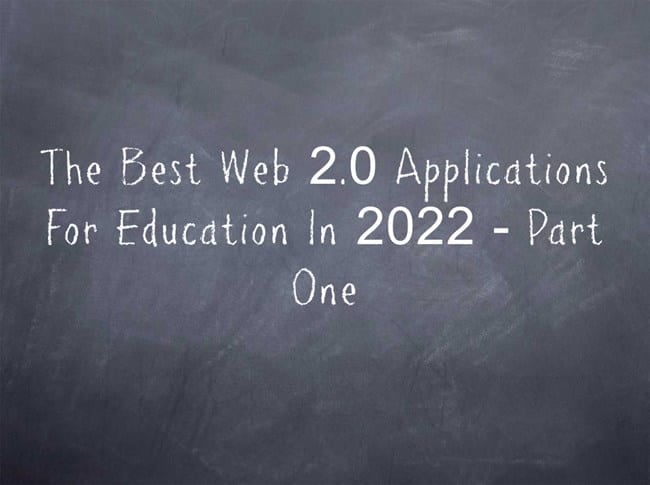As regular readers know, for the past fourteen years I’ve been publishing about twenty-five different bi-annual lists highlighting the best educational resources around (along with tons of other “Best” lists). You can see them all here.
It takes a lot of time to compile those lists, so I now do them every six months.
I’m starting off by focusing on Web 2.0 tools. It’s possible that a few of these sites began earlier than this year, but, if so, I’m including them in this list because they were “new to me” in 2022 (or in late 2021 after I published that year’s list).
As usual, in order to make this list, a site had to be:
* accessible to English Language Learners and non-tech savvy users.
* free-of-charge.
* appropriate for classroom use.
* completely browser-based with no download required (however, I’ve begun to make exceptions for special mobile apps).
You can see previous editions of these lists, along with all my Web 2.0-related lists, here. I completely revised and updated many of this this year.
I’ll review the tools on this list at the end of the year and only choose “the cream of the crop” for that final “annual” list.
Here are my choices for The Best Web 2.0 Applications For Education In 2022 – Part One. They are divided into three categories – Useful, Good, Excellent :
USEFUL
Text Chat Animator lets you create a video of an ongoing text chat that you, or students, can use in a video. I’m adding it to The Best Tools For Creating Fake “Stuff” For Learning.
I learned about Org.Pad from Jindřich Zdráhal. It’s like Padlet. I’m adding it to The Best Online Virtual “Corkboards” (or “Bulletin Boards”) .
Google unveiled a new Google Arts and Culture site called Manga Out Of The Box. Not only does it have a zillion multimedia features where you can learn about manga, but it also has a feature that allows you to create manga figures with the help of Artificial Intelligence. As any teacher knows, Manga is hugely popular among many students, so we teachers should be able to use this site for a variety of potential lessons and activities.
Adventr lets you create interactive videos.
Facebook has created an online tool called Sketch Canvas that lets you upload of a simple drawing, and then it will animated it. I’m adding it to The Best Ways For Students To Create Online Animations.
Create your own talking avatar with…Talking Avatar.
Memory looks like an interesting flashcard maker. I’m adding it to The Best Tools To Make Online Flashcards.
Instacap lets you annotate websites. I’m adding it to The Best Applications For Annotating Websites.
“Listikle is a web application that is designed to quickly create visually attractive list-based pages.”
Grafico is a new tool for creating infographics. I’m adding it to The Best Resources For Creating Infographics.
Supa is a new and what seems to be easy way to create engaging videos.
Sumo Paint is a drawing tool. It has a specific section for educators. I’m adding it to The Best Art Websites For Learning English.
Pixel Paper is a nice online whiteboard. I’m adding it to The Best Online Tools For Real-Time Collaboration.
GOOD
Phideo lets you easily create slideshows with music, and it’s free. You can read more about it at Richard Byrne’s blog. Adobe Creative Express, previously called Adobe Spark, will still be my “go-to” tool for this kind of project, but I’m still adding Phideo it to The Best Ways To Create Online Slideshows.
I, like many grandparents, made up stories to tell my grandchildren. At the time, I didn’t think of turning them into books for them to read. Now, though, I have younger grandkids again, and decided it would be nice to turn my stories into paper books for them to read (as well as reading them aloud to them). I figured there had to be some super-easy online tools out there that enable people to quickly turn their stories into children’s books. And, I was right! BookBildr lets you do it with their collection of ready-made illustrations, and you can get a 24 page physical book for under $18. It also has a section for educators. There are probably better tools, however, if you just want your students to create online books.
EXCELLENT
Google unveiled a new tool called Aloud. If you create a video in one language, you just upload the text narration and Aloud will “dub” your video in one of several languages (and they plan on adding more). So, according to Google, it would be simple for a teacher who creates their own videos in English to make others dubbed in the home language of ELL students. Just as many content teachers, including me, use tools at The Best Multilingual & Bilingual Sites For Math, Social Studies, & Science to use a version of the Preview/View/Review bilingual education model (Introduce the lesson in the home language, do the lesson in English, review it in the home language), it would be possible for content teachers to ask ELLs to watch the dubbed version, then the English version, and then do other follow-up activities in English. For example, that’s what I do with Brainpop now – students watch the Spanish-language version, then the English one, and then do the assessments and interactive exercises in English. Providing students with that kind of prior knowledge enhances their ability to understand the content, and to learn and understand English. It can also be useful for creating videos for parents. Unfortunately, it’s still available to everybody – you have to request early access.




Recent Comments